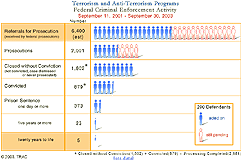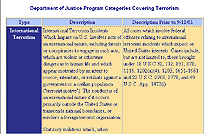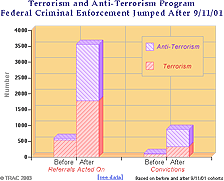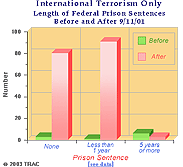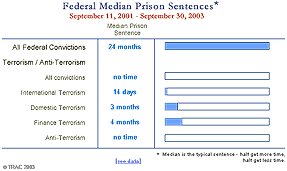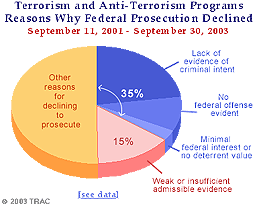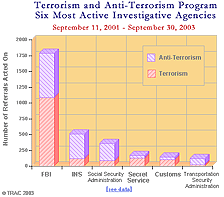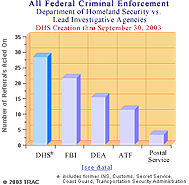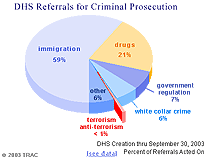
Criminal Terrorism Enforcement
Since the 9/11/01 Attacks
A TRAC Special Report
December 8, 2003
Updated (9/4/2006): Criminal Terrorism Enforcement During the Five Years Since the 9/11/01 Attacks
Contribute to TRAC In the two years since 9/11/01, federal investigators recommended the prosecution of more than 6,400 individuals who the government concluded had either committed terrorist acts or who were targeted on the grounds that charging them with some crime might "prevent or disrupt potential or actual terrorist threats."
On the basis of these recommendations, as of September 30, 2003, the government had in one way or another completed the processing of 2,681 individuals who had been subject to these investigative referrals. An analysis of case-by-case Justice Department data obtained by the Transactional Records Access Clearinghouse (TRAC), however, further showed that of the convicted only five have so far been sentenced to twenty years or more in prison and that for those categorized as international terrorists the median sentence — half got more, half got less — was 14 days (see figure 1).
Figure 1. Click for larger image. Because the Bush Administration is now withholding information that the government had previously released to the Transactional Records Access Clearinghouse (TRAC), it no longer is possible to determine the exact number of individuals who the investigative agencies recommended be prosecuted and who the prosecutors then categorized as falling into one of two classifications — "terrorism" or "anti-terrorism." However, TRAC's analysis of Justice Department data estimates that since 9/11/2001 the total number of such "referrals" involves more than 6,400 individuals.
[Special note. Most of the counts and percents presented in this special report are based on an examination of a "cohort" of all cases that have come in the government's door since 9/11/01. The processing of each case in the cohort was then followed up to September 30, 2003. For comparison, a similar cohort was examined for cases that were referred during the two years prior to 9/11 (October 1, 1999 thru September 10, 2001). This type of analysis is particularly useful when the goal is to examine the impact of a major event such as 9/11. The resulting figures will differ somewhat from what the Department of Justice reports as their activity in a specific year. This is because under the conventional agency presentation actions taken during one year may involve matters that were already in process in the previous year.]
The General Accounting Office (GAO) reported in January of 2003 that the Justice Department's classification system in this area was flawed. It recommended that the department be more exacting in the way it categorized the cases, an essential requirement for realistic assessment of this very important work. At this point, however, it is not known how well the department has acted on the GAO's recommendation.
Whatever the case, the absolute number of terrorism and anti-terrorism situations that have been recorded by assistant U.S. attorneys around the country in the last two years is sobering, considerably more sweeping than suggested in administrative statements and news accounts. The data cover referrals made by the agencies between September 11, 2001 and September 30, 2003 that the Justice Department classified as terrorism or anti-terrorism and describe how the government has dealt with these matters in the ensuing months.
As a result of the 9/11 attacks, the Department added a number of new crime categories to its internal record-keeping system tracking actions that in its view are in some way related to terrorism. (See figure 2 for a table of program categories.) Most prominent among the new groupings is what it now calls "Anti-Terrorism." This area, according to the department's data manual, covers immigration, identity theft, drug and other such cases brought by prosecutors that were "intended to prevent or disrupt potential or actual terrorist threats where the offense conduct is not obviously a federal crime of terrorism."
Figure 2. Click for table.
Even with the so-called anti-terrorism matters put aside, however, the data indicate that in the two years since 9/11 the Justice Department has been extremely active. Here are the counts for the presumably more serious "terrorism" category. Of the 6,400-plus terrorist and anti-terrorist matters referred to the prosecutors by the investigative agencies during the period more than half - about 3,500 of them — were classified as involving actual acts of terrorism — international terrorism, domestic terrorism and financial terrorism (see figure 3).
Figure 3. Click for larger image. (By comparison, in the same two-year period, federal investigators recommended the prosecution of about 3,600 official corruption matters and 2,400 environmental matters.)
Trends Over Time
Without question, the events of 9/11 resulted in a dramatic escalation in the government's enforcement activities in the terrorism area. To further document this shift, TRAC pulled together the data it has obtained from the Justice Department for referrals for prosecution received during the two years before September 30, 2001 and the two years after it. It then tracked what happened to cases within these before and after cohorts.
Figure 4. Click for larger image. In regard to all matters — both terrorism and anti-terrorism — there was a six-fold increase in cases that were either prosecuted or declined in the before and after 9/11 groups: from 594 such actions before to 3,555 after. There was an eight-fold jump in convictions, 110 to 879 (see figure 4).
Terrorism Only CasesSome of this growth may reflect the addition of "anti-terrorism" as a new tracking category under terrorism after 9/11 (see figure 2). And indeed, when anti-terrorism was put aside, the increase in the terrorism cases that were prosecuted or declined was less dramatic, from 544 to 1778. Convictions grew by three and a half times: from 96 before 9/11 to 341 after.
Counts of prosecutions and declinations, however, do not tell the whole story. Have these considerable enforcement efforts aimed at individuals alleged to have committed terrorists acts resulted in putting more terrorists behind bars for significant periods of time? Surprisingly, despite the three-and-a-half-fold increase in terrorism convictions, the number who were sentenced to five years or more in prison has not grown at all from pre-9/11 levels. In fact, the number actually declined, dropping from 24 individuals whose cases began before the attacks to 16 after. What has jumped are the numbers of individuals convicted but sentenced to little or no prison time (see figure 5).
Figure 5. Click for larger image.
International Terrorism Only CasesEven the Justice Department's counts for terrorism, however, cover a widely varying assortment of criminal violations. In an effort to compare apples with apples, TRAC undertook the same analysis for an even more more focused area: international terrorism.
Here, investigative referrals that were either prosecuted or declined increased five times, jumping from 142 individuals before the 9/11 attacks to 748 after. The climb in convictions was even sharper, jumping over seven and a half times, from 24 to 184. Once again, despite the increase in convictions, the number who received sentences of five or more years declined — from six individuals in the two years before 9/11 to only three in the two years after. Out of the 184 convictions under international terrorism, 171 have received either no prison time (80) or sentences of less than a year (91) (see figure 6).
Figure 6. Click for larger image. In summary, while Justice Department data showed that terrorism investigations, prosecutions and convictions all were sharply higher in the months after 9/11, the actual number of individuals who were sentenced to five or more years in prison years has fallen.
(CAUTION: Because there naturally is considerable delay at every stage of the criminal process, a substantial number of matters were still pending in the both the pre and post 9/11 cohorts at the time TRAC examined the cases. For international terrorism in the two years after 9/11, for example, over 600 matters were pending at the referral stage and 82 at the court stage. Because more serious cases often require more time to complete than easier ones, it is likely that when sentences are imposed in the pending cases that the number of individuals sent to prison for five or more years will increase. Nonetheless, a full two years after 9/11, it is surprising that there is as yet no measurable increase in international terrorists who were sentenced to a significant time in prison. All of the increase has occurred for those convicted receiving little or no prison time.)
Sentences
While comparing the terrorism enforcement patterns in the years before and after 9/11 provides a valuable perspective, a close examination of the two most recent years also is revealing. As already noted, a sizeable number of the referrals categorized as either terrorist or anti-terrorist matters since September 30, 2001 — 2,681 of them — had been disposed of as of the end of FY 2003. For all of these disposals, only 879 individuals had been convicted and 373 sentenced to prison. Analysis of the Justice Department data also shows that regardless of the category they fell into, the resulting sentences were surprisingly short (see figure 7). For example:
Figure 7. Click for larger image.
- The median or typical sentence for all those who the government classified as being involved in either kinds of terrorism in the years after 9/11 was zero days. In other words, more than half of this group were not sent to prison at all.
- Broken down by different kinds terrorist acts, the median sentence for those convicted of crimes the department categorized as involving international terrorism was 14 days, the median for domestic terrorism 3 months and the median for financial terrorism was 4 months
- Of the 879 individuals convicted of crimes classified as falling under either the terrorist or anti-terrorist umbrellas, the sentence for 263 of them was the time they had served awaiting the final resolution of their cases.
- In addition, 8 were sentenced to community service, 23 to drug or alcohol treatment, 17 to mental health treatment, 30 to home detention and one to community confinement. Fifteen showed downward departures supported by the government (3 for substantial assistance), and 3 listed upward departures.
- While a significant number of the 2,681 cases disposed of in the two years since 9/11 resulted in what many would consider minimal sentences, what about the other end of the scale? Of the 373 individual sentenced to prison for what the government classified as terrorism or anti-terrorism, only one individual was sentenced to life in prison and four received a sentence of 20 years or more.
Several factors should be considered in the interpretation of these sentences. As previously noted, an additional 874 cases have been filed in court but have not yet been completed. Because more serious matters may take longer to make their way through the criminal justice process, it is likely that the number of persons who will be sentenced to longer prison terms will increase.
Second, because of various sentencing guidelines, federal judges today have relatively little discretion in the sentences they impose.
Third, as a result of this reality, the sentences in this and all other kinds of criminal cases are largely determined by the investigators who collect the evidence and the prosecutors who decide the actual charges that will be brought against each individual.
Few would argue that the outcomes of the five cases resulting in a minimum of 20 years in prison are not important. Presumably we have prevented these particular individuals from attacking America again. But combined with the extremely low typical sentences so far imposed in all terrorism cases and the declining number sentenced to even five years in prison, the data would seem to raise certain pertinent questions about current strategies:
- Are the right people being targeted? Or have the FBI and other agencies adapted a general round up policy?
- Does the current approach of prosecuting a large number of individuals for crimes which frequently result in little or no prison — apparent in the data — reduce the chance of terrorism?
- Are other more effective strategies possible?
Effectiveness
Measuring the effectiveness of any enforcement effort is difficult. This is partly because there is no way to count the events that were prevented from happening by alert policing and strong locks — the bank robberies that were not attempted, the drug shipments that were not dispatched, the stock swindles that did not go forward. For terrorism — where the government's mission is nothing less than to "protect the American people" — assessing what it prevented is even more difficult.
It also should be recalled that while the Bush Administration has indeed recommended the prosecution of a large number of individuals who it said were involved in activities that fell into the terrorist or anti-terrorist categories, the government's prevention efforts involve at least four other broad kinds of work that in the main cannot be judged by such factors as the number of criminal convictions. The government, for example, also is responsible for guarding the borders, for taking steps to prevent the hijacking or bombing of airlines, for collecting intelligence about what the terrorists might be planning to do in the future, and for developing improved methods for preventing terrorists from disrupting the nation's electrical, communication and other networks.
One popular measure of enforcement effectiveness, however, has always involved a consideration of the sentences that have resulted from government prosecutions. In the terrorism area, as noted above, the data indicate that by this measure the government effort does not seem particularly impressive.
Figure 8. Click for table. When it comes to judging the performance of the investigative agencies a second and less well known measure is available: the reasons the assistant U.S. attorneys give when they decide a particular investigation is not worth prosecuting. Six out of every ten terrorism referrals and three out of every ten anti-terrorism referrals that have been acted on, were declined by U.S. Attorneys. (See figure 8.) This amounts to 1,048 terrorism and 506 anti-terrorism referrals that were declined.
For these terrorism and anti-terrorism referrals made since 9/11/2001 that were declined, the Justice Department data show that more than a third of them (34.9%) were rejected because the prosecutors decided they lacked evidence of criminal intent, or that there was minimal federal interest or that "no federal offense was evident." Another substantial number of referrals (14.9%) were declined because they were backed up by "weak or insufficient admissible evidence" (see figure 9).
Figure 9. Click for larger image. Arguably, terrorism enforcement is now the single most important challenge facing the Justice Department. And the fact that federal prosecutors have deemed just under half of these referrals (49.8%) unsuitable is disturbing. But very tough questions must be explored before a final judgment is rendered. Are federal prosecutors declining to bring charges because collecting evidence in these particular cases is so difficult? Or does the large number of negative judgments by the prosecutors indicate that the investigators are not doing a good job?
Finally, an essential fact about all kinds of law enforcement should be emphasized: the growth in the enforcement effort forcused on a problem like terrorism does not mean there has been a parallel growth in terrorist crimes. But an increase in police arrests or filings of criminal charges in regard to a particular kind of crime always is a clear sign that the government has decided that this is a problem that must be confronted.
Terrorism Cases - Who Is Getting the Longer Sentences?
Because the attacks of 9/11 were so shocking, the memory of them now tends to dominate what we mean when we think about terrorism. And the arrest, prosecution and conviction of Richard Reid certainly is a textbook example of this kind of case. Reid, who pleaded guilty to an attempt to blow up a Paris-to-Miami airline, was sentenced to life in prison on January 31, 2003 by a federal judge in Boston. Reid said he was a member of al-Qaida, a supporter of Osama bin Laden and, at his sentencing hearing, denounced U.S. foreign policy.
But looking at several more of the small number of "terrorism" cases that resulted in sentences of five or more years, it is clear that as defined by the government terrorism covers a lot more than an attempt to blow up an airplane. If properly implemented, this broader definition of terrorism may be a useful way for the government and the public to understand what is being done and not done in this sensitive area. If improperly used, however, the mis-labeling of cases could undermine the legitimacy of government efforts by turning the "terrorist" label into a convenient method to justify government actions sought for other purposes. If that happens, it also could undermine the effort of the courts to treat defendants in a fair and just way and make judging the effectiveness of the government extremely difficult.
Here, however, are several examples of "terrorism" cases that resulted in significant sentences. While the categorization appears to be consistent with current Justice Department definitions, they may not match the public's idea of terrorism arising out of the attacks of 9/11. In June of 2003, Mohamed Ali Alriany — a U.S. citizen for 23 years — was sentenced to five years and three months in prison after pleading guilty to charges relating to the shipment of millions of dollars in customers' money to Yemen through an unlicensed money-transfer business. This case was categorized as terror-related financing.
More distant from the 9/11 concept of terrorism are the cases the government classified as domestic terrorism.
Last April, for example, a federal judge in Louisiana called five Ku Klux Klan members "domestic terrorists" as he sentenced them to prison for burning a cross in the front yard of three black men. And the judge's view of the men echoed the judgment of the U.S. Attorney who classified the case in the department's internal record keeping system as a domestic terrorism matter. The ring leader of the splinter group who burned the cross was sentenced to almost 14 years in prison.
In other cases categorized as domestic terrorism, the connection may be more tenuous. For example, two cases that resulted in significant prison sentences included a Georgia man who was sentenced to 6 1/2 years for detonating a pipe bomb in the then-empty car of his girl friend and a Texas convict who attempted to arrange the assassination of a federal judge in Colorado from his prison cell in Texas.
A final note: this section of TRAC's special report has focused only on the handful of cases the government has classified as terrorism — international, domestic and financial — that resulted in a significant sentence. It has not attempted to deal with those cases the government has categorized as "anti-terrorism" — an area whose scope is yet to be clearly defined (see earlier figure 2).
Agencies
The FBI, for the last two years, is without doubt the dominant investigative agency when it comes to terrorism, credited with being the lead agency in about two out of three of all such cases (61.3%) that have been prosecuted or declined. The FBI was followed by the Secret Service (7.1%), the Immigration and Naturalization Service (6.9%), and the Customs Service (5.7%)
Figure 10. Click for larger image. For anti-terrorism matters, the FBI and the INS again have played major roles. The FBI, for example, was credited with more than one out of three of the anti-terrorism matters (39.3) prosecuted or declined, the INS with about one in five (21.6%). Two other active agencies were the Social Security Administration (15.3%) and the Transportation Security Administration (4.7%) (see figure 10).
Department of Homeland Security (DHS) and Terrorism
The DHS, of course, is a late starter, having only come into existence in the spring of 2003, 18 months after the 9/11 attacks. From TRAC's analysis of the Justice Department enforcement data covering only the recent seven-month period from March 1 (when DHS came into existence) to September 30, 200, two clear findings emerge.
First, the DHS has immediately established itself in the federal law enforcement scene. If DHS is considered a single organization, it has replaced the FBI as the lead criminal investigative unit within the federal government - at least in terms of the volume of criminal referrals of all types that are sent to federal prosecutors and were acted on (see figure 11).
Figure 11. Click for larger image. Here are the numbers. The DHS, considered as a whole, led all other agencies in the number of criminal matters presented by its investigators that were prosecuted or declined by the assistant U.S. attorneys in the first seven months of its life. The leading position of the new department in initiating well over a quarter of all kinds of criminal matters — 28.4% of the national total — is clear. Next in line was the FBI, with 21.6% of all matters. Other significant players were the Drug Enforcement Administration (15.4%), the Bureau of Alcohol, Tobacco, Firearms and Explosives (11.4%) and Postal Service (3.3%). [Note: if the law enforcement agencies - FBI, DEA, ATF - which are nominally part of the Justice Department are grouped together, then the Justice Department numbers would exceed those from DHS.]
Second, while the DHS has established itself as a dominant federal enforcement agency, terrorism and anti-terrorism matters paradoxically make up only a tiny fraction of its criminal case workload (see figure 12). This reality can be explained by the fact that most DHS investigators work for agencies like the INS and Customs that were transferred to the department on March 1.
Figure 12. Click for larger image. Considering all the DHS matters that have been prosecuted or declined in the last seven months, for example, the Justice Department classified four out of five (79.6%) of them as involving immigration and drugs violations. On the other hand, slightly less than 1% of all DHS prosecutions and declinations were categorized as terrorism or anti-terrorism matters.
The long-term impact of these changes on federal law enforcement is of course not known. But the sweeping re-organization of the government behind the creation of the DHS may result in unanticipated and even unwanted shifts. The rationale that was presented to justify DHS's creation was that it would group together under one roof the major components of the federal government whose mission was to combat the terrorist threat, and thereby lead to a more effective effort*. An issue that was not widely debated at the time was what would happen to the many other functions, apart from combating terrorism, that the agencies transferred into DHS have historically served.
The Secret Service, for example, has long been the federal government's lead agency when it came to the prevention of counterfeiting. Now, as a component of the DHS, will that historic mission necessarily become less urgent?
The same point might hold for the Immigration and Naturalization Service which for many years has pursued two missions: protecting the borders against illegal migrants (few of whom are potential terrorists) and at the same time smoothing the entry of foreign students, research scientists, business executives and tourists so important to the American economy. Further, its staffing has been focused along the southwest border with Mexico - is that the same deployment pattern needed to combat the terrorism threat? (See August 25, 2003 TRAC Report on the DHS.)
In recent years, one of the most important agencies in the war on drugs has been the Customs Bureau. With the move of Customs to DHS, will that war become less urgent?
And finally, do top executives within the DHS have the experience they need to manage what has abruptly become America's largest enforcement agency for non-terrorism matters?
Regional Variation
Two years after 9/11, every one of the 90 federal districts in the country has handled at least one terrorism case. So have Puerto Rico, Guam, and the Virgin Islands. The volume of cases, however, varies sharply by district (see figure 13).
Figure 13. Click for larger image. Given the very special nature of terrorism and the challenge of combating it, it is hardly surprising that in the last two years federal enforcement efforts have been far more vigorous in some parts of the country than in others. Even so, however, some aspects of the regional distribution of these cases are of interest.
The Federal Rules of Criminal Procedure suggest that as a general practice criminal cases should be brought in the area where the alleged crime was committed. Under law and custom, however, the government has always had some discretion in deciding where a case will be filed.
And without doubt, the data suggest that the Eastern District of Virginia (Alexandria), right next to Washington, DC, is the Justice Department's favorite venue when it comes to terrorism. (Criminal defense lawyers say the department prefers the Virginia district for two reasons: it is close to Washington and the relevant court of appeals is generally considered the most conservative in the nation.)
(One alternative explanation for the concentration of terrorism cases in this district is that the assistant U.S. attorneys there are quicker to apply this label than the assistant U.S. attorneys in other districts. While this is possible, the definitions for these and all other kinds of criminal cases are spelled out with considerable precision in a department manual that prosecutors all over the nation are at least in theory required to abide by. (See earlier figure 2.)
The concentration of terrorism enforcement actions in Virginia's Eastern District is demonstrated by the fact that in the last two years federal prosecutors there prosecuted or declined 346 terrorism matters — one out of five (19.5%) of all such actions in the nation. Next highest among the 90 districts in the United States — although far behind — was North Carolina West (Asheville) with 3.9% of all prosecutions and declinations, Michigan East (Detroit) with 3.5%, New York West (Buffalo) with 2.9%, and New York East (Brooklyn) with 2.7%. (By comparison, only 1.9% of the terrorism matters that were either prosecuted or declined any where in the U.S. were recorded the U.S. Attorneys office in New York South (Manhattan) where the World Trade Center is located.
Concerning anti-terrorism, the Eastern District of Virginia (Alexandria) again led the pack with 11.1%, followed by Texas South (Houston) with 9.6%, New Jersey (Newark) with 7.4%, California Central (Los Angeles) with 6.5% and the District of Columbia with 4.8%.
* For a variety of historical and political reasons, however, neither the FBI nor the CIA were placed within the DHS.
[Further details on each case can be obtained using TRAC's online query service at TRAC Spotlight.]
Earlier TRAC Terrorism Reports
| December 2001 | June 2002 | February 2003 |For more detailed information, TRACFED subscribers may use:
| TRAC terrorism database |
